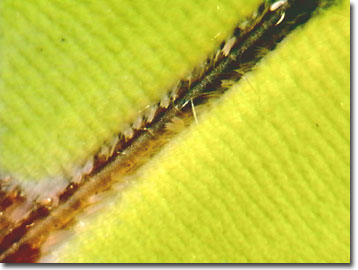Butterfly Wing Scale Digital Image Gallery
Blue Triangle Butterfly
Man cannot always successfully reproduce what occurs in nature. The blue triangle butterfly reared in captivity is distinctly different from those existing in the wild. Unfortunately for the survival of the species, the smaller, less intensely colored captive-bred individuals are less desirable to collectors.

Graphium sarpedon earns its common name from the characteristic turquoise patches in the middle of its forewings and hind wings. The patches form a triangle with the apex pointing toward the tip of the lepidopteran's abdomen. Blue triangle butterflies bred in captivity display greener wing triangles and often lack the brilliance of free, native specimens. The greater demand for turquoise specimens by butterfly collectors and artists places strains on wild populations in some parts of the blue triangle's native Indo-Australian range.
There are occasionally naturally occurring problems in the lifecycle of the blue triangle butterfly species. Usually, female blue triangles lay their round eggs on new shoots of a suitable host plant, such as camphor, laurel, or cinnamon. Sometimes, however, they mistakenly leave eggs on inappropriate plants, such as avocado. The low activity level of the blue triangle butterfly larvae makes this occasional error in judgment especially hazardous. Relatively sluggish for caterpillars, the larvae generally feed on a single spray of leaves for their entire larval life and then pupate on the same plant. If they hatch from eggs on an unsuitable plant, they are not likely to seek a different one to feed upon and may starve.
When disturbed, blue triangle caterpillars exhibit defensive behaviors. Rearing up on their legs, the caterpillars expose a pair of pale yellow or green fleshy horns, known as the osmeteria, from a pocket behind the head. Each osmeterium can extend, swell, and emit a chemical substance with the strong scent of camphor. The foul odor often repels potential predators, but if it does not, the osmeteria offer additional protection. If a predator continues to attack, it is likely to strike the swollen osmeteria in lieu of the vital caterpillar head, which is tucked down and away.
Contributing Authors
Cynthia D. Kelly, Shannon H. Neaves, Laurence D. Zuckerman, and Michael W. Davidson - National High Magnetic Field Laboratory, 1800 East Paul Dirac Dr., The Florida State University, Tallahassee, Florida, 32310.
BACK TO THE BUTTERFLY WING SCALE IMAGE GALLERY
BACK TO THE DIGITAL IMAGE GALLERIES
Questions or comments? Send us an email.
© 1995-2025 by Michael W. Davidson and The Florida State University. All Rights Reserved. No images, graphics, software, scripts, or applets may be reproduced or used in any manner without permission from the copyright holders. Use of this website means you agree to all of the Legal Terms and Conditions set forth by the owners.
This website is maintained by our
Graphics & Web Programming Team
in collaboration with Optical Microscopy at the
National High Magnetic Field Laboratory.
Last Modification Friday, Nov 13, 2015 at 01:19 PM
Access Count Since January 21, 2003: 10312
Visit the website of our partner in introductory microscopy education:
|
|
